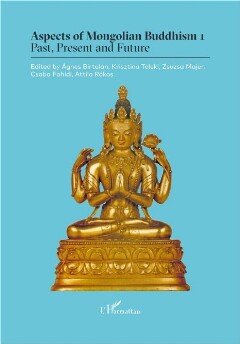Page 417 [417]
CZECHOSLOVAK ACADEMIC STUDY OF BUDDHISM IN THE 1950s AND 1960s: FIELD RESEARCH IN ASIA
well as an active collection of Buddhist artefacts — or, as it was called at the time, of
‘Lamaist art’ — from the local residents, but mainly from secret hiding places, where
the faithful had hidden these artefacts to protect them from certain destruction during
the time of the great repressions (for example, in the late 1930s.) A crucial part of the
documentation was the photographing and description of the holdings in the local
museums they visited during their travels. A result from this expedition was a study
published in French. Their next and last collaboration was a brief contribution to a con¬
ference proceedings edited by Jan Filip.” This text, however, did not address the second
expedition of 1963, but the first of 1958 and therefore focused on the archeology of
the Kiiltegin monument.” Jis] went on to independently publish the main results of
the third expedition in Polish.”
It was the great desire of Lumir Jis| to return to Mongolia very soon after the trip of
1963, but circumstances sadly did not allow for this. After 1963, i.e., after his return
from the expedition, he was obliged to concentrate on other foreign working trips in
Europe, as well as completing his dissertation on the Orkhon Turks.” He devoted
a considerable amount of time to the preparation and realization of his project as well
of processing the Mongolian collections of Hans Leder in several different museums
(in Hamburg, Bonn, and Heidelberg); travelling to West Germany from May 24" 1967
to May 29" 1968, on the basis of a Humboldt scholarship. And before that, in 1963, he
was able to spend a month in France, where he worked in the Musée Guimet in Paris
from November 14" to December 13". In 1964, he was in Paris again for a month (May
18 — June 14"), and shortly before that, in Vienna (April 27" — May 3").
The peak of Jisl’s scientific research abroad was his year-long stay in West Germany,
where he resided from May 24" 1967 to May 29" 1968 on the basis of a prestigious
Humboldt scholarship. Here Jisl was a guest at several universities: he lectured about
2° Jisl, Lumir — Ser-od-jave, Namsrain: Fouilles du monument de Kül-tegin en République populaire de
Mongolie. In: Filip Jan (ed.): Investigations archéologiques en Tchécoslovaquie. Academia, Praha 1966,
pp. 291-292. Professor Jan Filip (December 25, 1900, Chocnéjovice — April 30, 1981, Praha) was at
this time (1963-1974) the director of the Archaeological Institute of the Czechoslovak Academy of Sci¬
ences. Jan Filip edited as well, for more than a quarter century, the professional journal Archeologické
rozhledy [Archaeological Perspectives], which he founded with the previous director of the Archeological
Institute, Jaroslav Bohm, in 1949.
Jisl published several studies on the theme of the excavations of Kiiltegin’s Monument, the most sig¬
nificant of which is the paper published in Turkish: Jisl, Lumir: Kül-Tegin anitinda 1958, de Yapilan
Arkeoloji arastirmalarinin soluctari. Türk-Tarih Bulletin, Cilt 27, Ankara 1963, pp. 387-402, ill. 403-410.
See Jisl, Lumir: Nowe odkrycia archeologiczne w gérach Mongolii [The New Archaeological in the
Mongolian Mountains]. Acta Archaelogica Carpathica, Band 7, Krakow (1965), pp. 117-124.
Jisl, Lumir: Orchonsti Turci a problemy archeologie druheho vychodotureckeho kaganätu [The Orkhon
Turks and the Problems of the Archaeology of the Second Eastern Turk Khaganate]. I-IV. vol., Praha
1963 [unpublished doctoral dissertation at the Archaeological Institute of the Academy of Sciences of
Czechoslovakia in Prague, p. 313, 195 tables, p. 92. of inventories, 16 maps]. This work was published
posthumously in English translation thanks to the unsparing efforts of Jisl’s wife as: Jisl, Lumir: The
Orkhon Türks and Problems of the Archaeology of the Second Eastern Tiirk Kaghanate. Annals of the
Naprstek Museum 18 (1997), p. 160.
415

